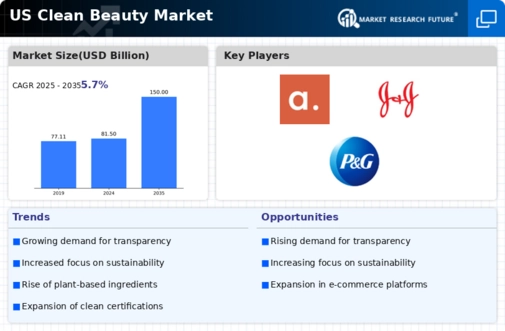Rise of Eco-Conscious Consumers
The clean beauty market is witnessing a notable rise in eco-conscious consumers who prioritize sustainability in their purchasing decisions. This demographic shift is characterized by a preference for products that are effective and environmentally friendly. Research indicates that around 60% of US consumers are willing to pay a premium for sustainable beauty products. This willingness to invest in eco-friendly options is prompting brands to adopt sustainable practices, such as sourcing ingredients responsibly and minimizing waste. Consequently, the clean beauty market is evolving to meet the demands of this environmentally aware consumer base, which is likely to drive innovation and growth in the industry.
Regulatory Changes and Standards
The clean beauty market is affected by evolving regulatory changes and standards that govern product formulations and labeling. Recent initiatives by regulatory bodies aim to enhance consumer safety and promote transparency in the beauty industry. For instance, new guidelines may require stricter testing of ingredients and clearer labeling practices. These changes could compel brands to reformulate products to comply with regulations, thereby influencing market dynamics. As companies adapt to these regulatory shifts, the clean beauty market may experience increased competition, as brands that prioritize compliance and safety are likely to gain consumer trust and market share.
Consumer Awareness of Ingredients
The clean beauty market is experiencing a surge in consumer awareness regarding the ingredients used in personal care products. This heightened scrutiny is driven by a growing demand for transparency and safety, as consumers increasingly seek products free from harmful chemicals. According to recent data, approximately 70% of consumers in the US express a preference for brands that disclose their ingredient lists. This trend is compelling companies within the clean beauty market to reformulate products and prioritize natural ingredients, thereby enhancing brand loyalty and trust. As a result, brands that effectively communicate their ingredient sourcing and safety measures are likely to gain a competitive edge in the clean beauty market.
Demand for Personalized Beauty Solutions
The clean beauty market is increasingly responding to the demand for personalized beauty solutions tailored to individual consumer needs. This trend is driven by advancements in technology, such as AI and data analytics. These advancements enable brands to offer customized products based on skin type, preferences, and concerns. Approximately 55% of consumers express interest in personalized beauty products, indicating a shift towards individualized experiences. As brands within the clean beauty market embrace this trend, they are likely to enhance customer satisfaction and loyalty, ultimately contributing to growth in the industry. This focus on personalization may also lead to innovative product development and marketing strategies.
Influence of Social Media and Digital Marketing
The clean beauty market is significantly influenced by social media and digital marketing strategies. Platforms such as Instagram and TikTok have become vital channels for brands to engage with consumers, showcasing product benefits and ingredient transparency. Approximately 80% of consumers report that social media impacts their purchasing decisions, particularly among younger demographics. This trend encourages brands to leverage influencer partnerships and user-generated content to enhance their visibility and credibility. As a result, the clean beauty market is increasingly reliant on digital marketing tactics to reach and resonate with consumers, potentially reshaping traditional marketing approaches within the industry.














Leave a Comment